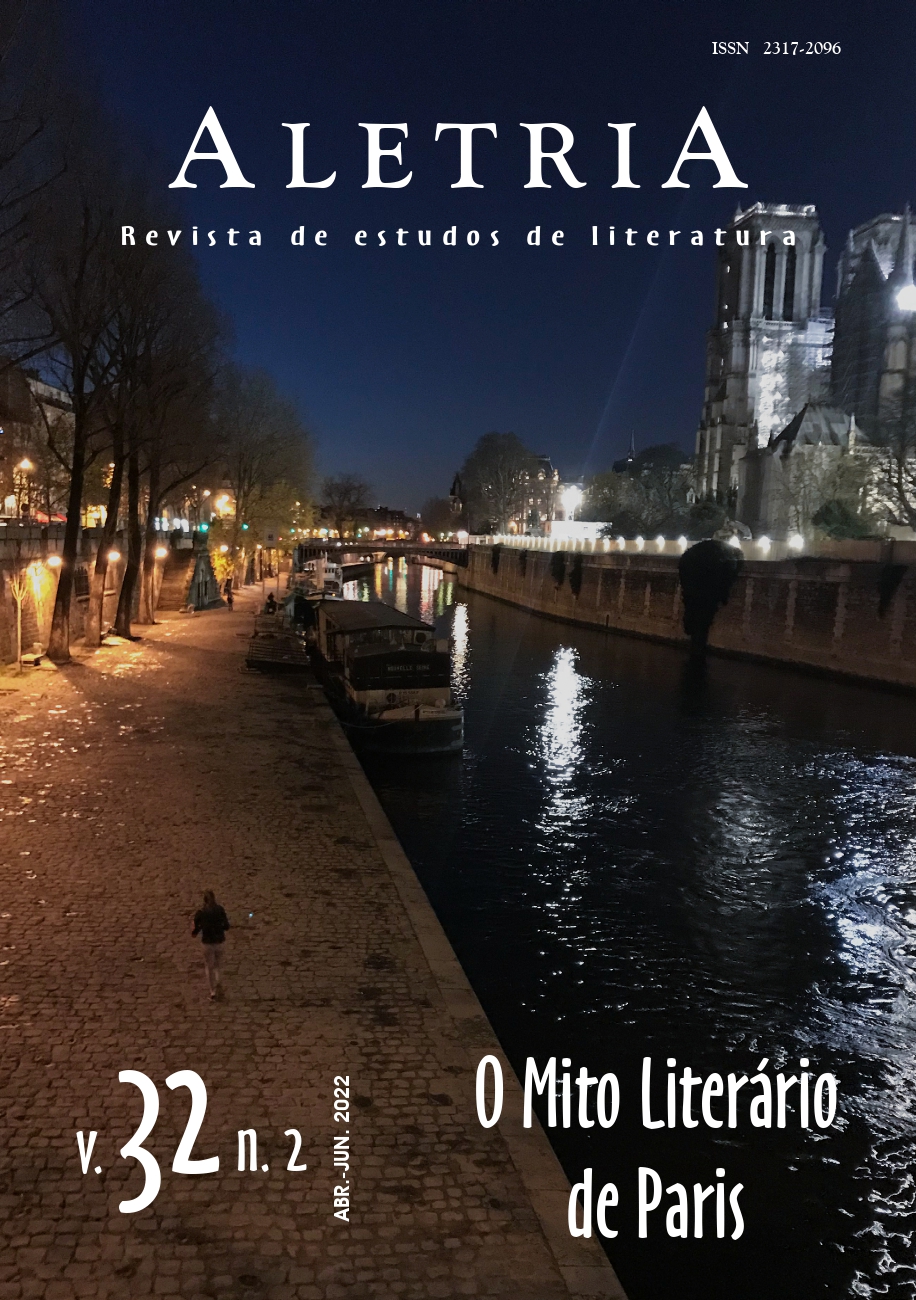Baudelaire-Paris, Creation of a Perceptive and Phantasmagorical Mythology
DOI:
https://doi.org/10.35699/2317-2096.2022.38258Keywords:
Baudelaire, Paris, synesthesias, perceptive imagination, Modernity, mythologyAbstract
Abstract: How did Baudelaire construct the myth of Paris in the mid-19th century? His idealism, incompatible with the industrial and positivist society of the Second Empire, led him to weave new relations between humans and the world to beautify modernity. We’ll first analyze the construction of the myth of Paris from the disenchanted, realistic picture that Baudelaire paints. Then we’ll observe how Baudelaire metamorphosizes urban space. As a response to Haussmann’s dismembered Paris, Baudelaire creates inner landscapes reconstructed by imagination and memory, with the interplay of correspondances forming a mystical cosmology. As the theater of a phantasmagorical scenography, Paris takes on the appearance of a Chimera and acquires a new psychological and poetic density. Finally, we’ll look at the importance of receptive feeling. The reader takes part in the construction of this living myth by an active and emotional reading, thus bestowing on the capital an individual, subjective and universal dimension.
Downloads
References
BACHELARD, Gaston. L’Air et les songes. Paris : Librairie José Corti ; Librairie Générale Française, 2004.
BAUDELAIRE, Charles. Œuvres complètes. Paris : Gallimard, 1975. v. 1. (Collection Bibliothèque de la Pléiade).
BAUDELAIRE, Charles. Œuvres complètes. Paris : Gallimard, 1976. v. 2. (Collection Bibliothèque de la Pléiade).
BENJAMIN, Walter. Charles Baudelaire, un poète à l’apogée du capitalisme. Paris : Payot, 2002.
BERTRAND, Aloysius. Gaspard de la nuit. Paris : Gallimard, 1980.
CALLE-GRUBER, Mireille (dir.). L’Amour du monde à l’abri du monde dans la littérature. Paris : Hermann Editeurs, 2015.
CHAR, René. Le marteau sans maître suivi de Moulin premier. Paris : José Corti, 1934.
CHENET-FAUGERAS, Françoise. L’invention du paysage urbain. Romantisme, n. 83, p. 27-38, 1994.
COLLOT, Michel. Chaosmos. Paris : Belin, 1998.
CREPET, Eugène ; CREPET, Jacques. Charles Baudelaire. Appendice V. Paris : Messein, 1928.
FLAMEL, Nicolas. Le livre des figures hiéroglyphiques. Chez la veuve M. Guillemot & S. Thiboust, 1612. Disponible dans : https://livres-d-hermes.com/PDF/LLDFHI01.PDF. Accès dans : 16 out. 2021.
FONDANE, Benjamin. Baudelaire et l’expérience du gouffre. Bruxelles : Editions Complexe, 1994.
GAUTIER, Théophile. Préface. In : BAUDELAIRE, Charles. Œuvres complètes de Baudelaire. Paris : PUPS, 2007.
HUGO, Victor. Tas de Pierre. In : ALBOUY, Pierre. Œuvres poétiques, I : édition critique. Paris : Gallimard, 1964. p. 1479.
HUGO, Victor. Lettre à Baudelaire, 6 octobre 1859. In : BAUDELAIRE, Charles. Œuvres complètes. Paris : Gallimard, 1975.
ISAL, Florelle. Poésie et synesthésie dans l’œuvre de Charles Baudelaire : une poétique de la totalité entre imagination sensible et savoir. 2019. Thèse (Doctorat en Langue, Littérature et Civilisation Françaises) – Sorbonne-Nouvelle Paris III, Paris, 2019.
JOYCE, James. Finnegans Wake. Londres : Faber & Faber ; Paris : Gallimard, 1997.
LABARTHE, Patrick. Paris comme décor allégorique. L’Année Baudelaire, Paris, n. 1, p. 44, 1995.
REVERZY, Éléonore (dir.). Les Goncourt, objets et paradoxes d’une idéologie de la mode. Cahiers Edmond et Jules de Goncourt, Paris, n. 25, 2019.
SCHEFER, Olivier. Romantisme et œuvre d’art totale : variations sur la totalité. Po&sie, [s. l.], n. 128-129, p. 193-210, 2009.
SCEPI, Henri. Le rythme du chant (à propos de Max Elskamp). Textyles, [s. l.], v. 22, p. 33-42, 2003.
SCEPI, Henri. Baudelaire / Laforgue : la ville au croisement du poème. Les imaginaires de la ville : Entre littérature et arts, Rennes, p. 463-474, 2007. (Interférences).
SEGALEN, Victor. Essai sur l’exotisme. In : BOUILLIER, Henri. Œuvres complètes : cycle des ailleurs et du bord du chemin. Paris : Robert Laffont, 1995.
Downloads
Published
How to Cite
Issue
Section
License
Copyright (c) 2022 Florelle ISAL (Autor)

This work is licensed under a Creative Commons Attribution 4.0 International License.
Authors who publish with this journal agree to the following terms:Authors retain copyright and grant the journal right of first publication with the work simultaneously licensed under a Creative Commons Attribution Non-Commercial No Derivatives License that allows others to share the work with an acknowledgement of the work's authorship and initial publication in this journal.Authors are able to enter into separate, additional contractual arrangements for the non-exclusive distribution of the journal's published version of the work (e.g., post it to an institutional repository or publish it in a book), with an acknowledgement of its initial publication in this journal.Authors are permitted and encouraged to post their work online (e.g., in institutional repositories or on their website) prior to and during the submission process, as it can lead to productive exchanges, as well as earlier and greater citation of published work (See The Effect of Open Access).





